KIA CARENS RHD 2018 Owners Manual
Manufacturer: KIA, Model Year: 2018, Model line: CARENS RHD, Model: KIA CARENS RHD 2018Pages: 723, PDF Size: 40.94 MB
Page 541 of 723
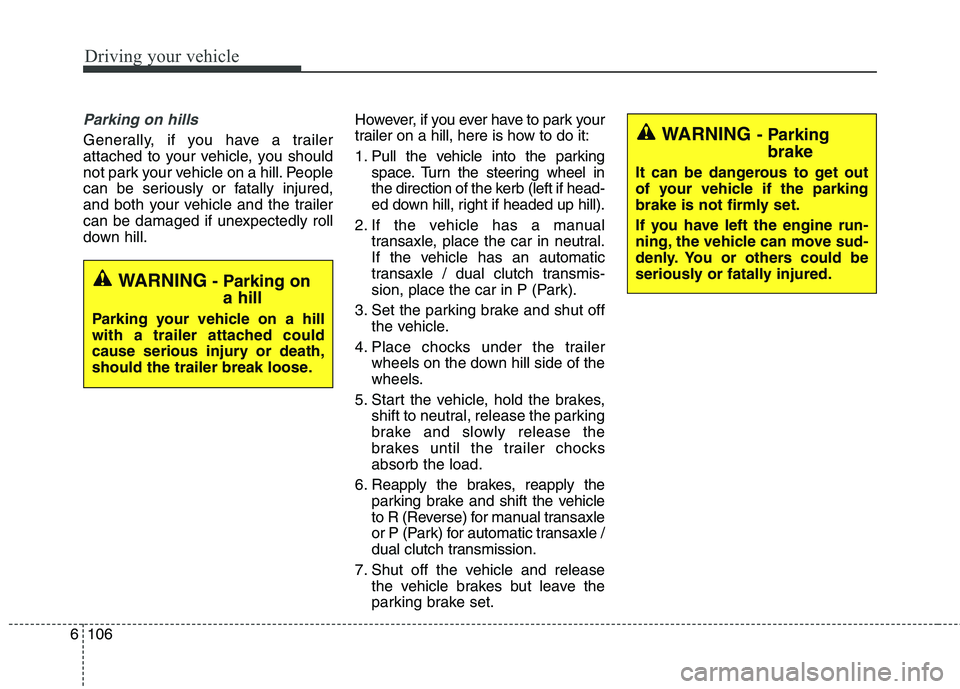
Driving your vehicle
106
6
Parking on hills
Generally, if you have a trailer
attached to your vehicle, you should
not park your vehicle on a hill. People
can be seriously or fatally injured,
and both your vehicle and the trailer
can be damaged if unexpectedly roll
down hill. However, if you ever have to park your
trailer on a hill, here is how to do it:
1. Pull the vehicle into the parking
space. Turn the steering wheel in
the direction of the kerb (left if head-
ed down hill, right if headed up hill).
2. If the vehicle has a manual transaxle, place the car in neutral.
If the vehicle has an automatic
transaxle / dual clutch transmis-
sion, place the car in P (Park).
3. Set the parking brake and shut off the vehicle.
4. Place chocks under the trailer wheels on the down hill side of the
wheels.
5. Start the vehicle, hold the brakes, shift to neutral, release the parking
brake and slowly release the
brakes until the trailer chocksabsorb the load.
6. Reapply the brakes, reapply the parking brake and shift the vehicle
to R (Reverse) for manual transaxle
or P (Park) for automatic transaxle /
dual clutch transmission.
7. Shut off the vehicle and release the vehicle brakes but leave the
parking brake set.
WARNING - Parking on
a hill
Parking your vehicle on a hill
with a trailer attached could
cause serious injury or death,
should the trailer break loose.
WARNING - Parking
brake
It can be dangerous to get out
of your vehicle if the parking
brake is not firmly set.
If you have left the engine run-
ning, the vehicle can move sud-
denly. You or others could be
seriously or fatally injured.
Page 542 of 723

6107
Driving your vehicle
When you are ready to leave after
parking on a hill
1.With the manual transaxle inNeutral or automatic transaxle /
dual clutch transmission in P
(Park), apply your brakes and hold
the brake pedal down whilst you:
and
2.Slowly remove your foot from the brake pedal.
3.Drive slowly until the trailer is clear of the chocks.
4.Stop and have someone pick up and store the chocks. Maintenance when trailer tow- ing
Your vehicle will need service more
often when you regularly pull a trail-
er. Important items to pay particularattention to include engine oil,
transaxle fluid, axle lubricant and
cooling system fluid. Brake condition
is another important item to frequent-
ly check. Each item is covered in this
manual, and the Index will help you
find them quickly. If you’re trailering, it
is a good idea to review these sec-
tions before you start your trip.
Do not forget to also maintain your
trailer and hitch. Follow the mainte-nance schedule that accompanied
your trailer and check it periodically.
Preferably, conduct the check at the
start of each day’s driving. Most
importantly, all hitch nuts and boltsshould be tight.CAUTION
Due to higher load during
trailer usage, overheatingmight occur in hot days or during uphill driving. If thecoolant gauge indicates over-heating, switch off the air con- ditioner and stop the vehiclein a safe area to cool down theengine.
When towing check transaxle fluid more frequently.
If your vehicle is not equipped with an air conditioner, youshould install a condenser fanto improve engine perform-ance when towing a trailer.
Page 543 of 723
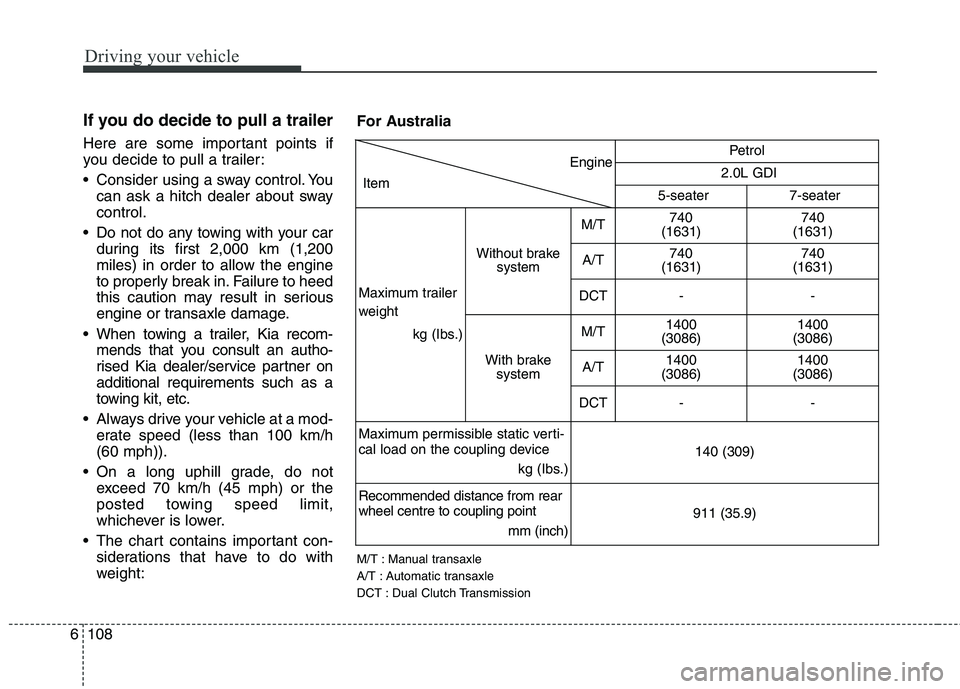
Driving your vehicle
108
6
If you do decide to pull a trailer
Here are some important points if
you decide to pull a trailer:
Consider using a sway control. You
can ask a hitch dealer about sway control.
Do not do any towing with your car during its first 2,000 km (1,200
miles) in order to allow the engine
to properly break in. Failure to heed
this caution may result in serious
engine or transaxle damage.
When towing a trailer, Kia recom- mends that you consult an autho-
rised Kia dealer/service partner onadditional requirements such as a
towing kit, etc.
Always drive your vehicle at a mod- erate speed (less than 100 km/h(60 mph)).
On a long uphill grade, do not exceed 70 km/h (45 mph) or the
posted towing speed limit,
whichever is lower.
The chart contains important con- siderations that have to do with
weight:
Engine
ItemPetrol
2.0L GDI
5-seater 7-seater
Maximum trailer
weight kg (Ibs.)
Without brakesystem
M/T740
(1631) 740
(1631)
A/T740
(1631) 740
(1631)
DCT--
With brake system
M/T1400
(3086) 1400
(3086)
A/T1400
(3086) 1400
(3086)
DCT--
Maximum permissible static verti-
cal load on the coupling device kg (Ibs.)
140 (309)
Recommended distance from rear wheel centre to coupling point mm (inch)
911 (35.9)
For Australia
M/T : Manual transaxle
A/T : Automatic transaxle
DCT : Dual Clutch Transmission
Page 544 of 723
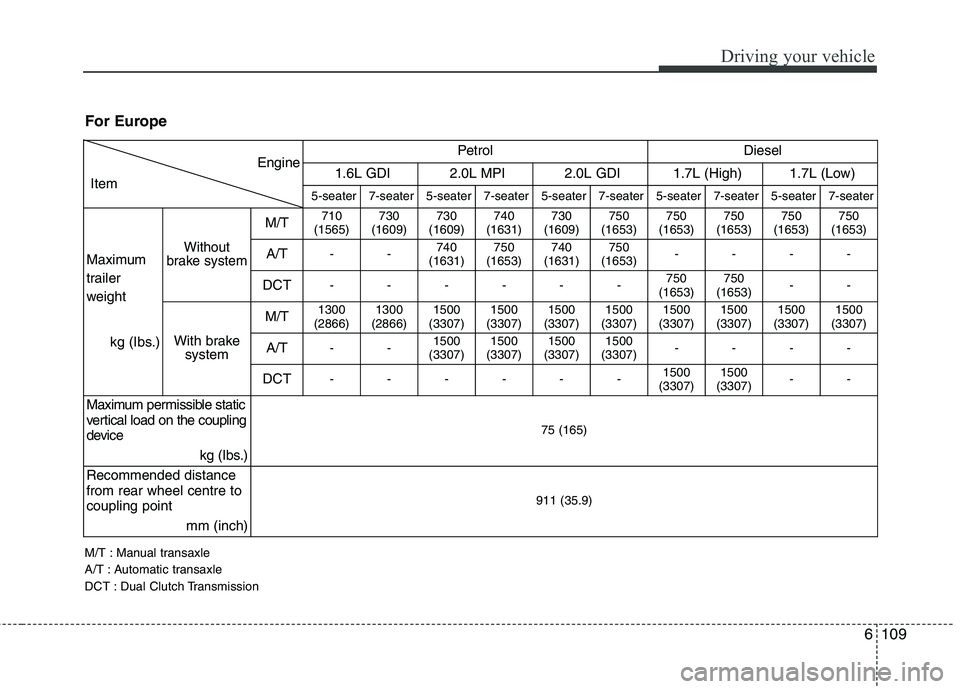
6109
Driving your vehicle
For Europe
M/T : Manual transaxle
A/T : Automatic transaxle
DCT : Dual Clutch Transmission
Engine
ItemPetrol Diesel
1.6L GDI2.0L MPI 2.0L GDI 1.7L (High) 1.7L (Low)
5-seater7-seater5-seater 7-seater 5-seater7-seater 5-seater 7-seater 5-seater 7-seater
Maximum
trailer
weight kg (Ibs.)
Without
brake system
M/T710
(1565)730
(1609)730
(1609) 740
(1631) 730
(1609)750
(1653) 750
(1653) 750
(1653) 750
(1653) 750
(1653)
A/T--740
(1631) 750
(1653) 740
(1631)750
(1653) ----
DCT------750
(1653) 750
(1653) --
With brake system
M/T1300
(2866)1300
(2866)1500
(3307) 1500
(3307) 1500
(3307)1500
(3307) 1500
(3307) 1500
(3307) 1500
(3307) 1500
(3307)
A/T--1500
(3307) 1500
(3307) 1500
(3307)1500
(3307) ----
DCT------1500
(3307) 1500
(3307) --
Maximum permissible static
vertical load on the coupling
device kg (Ibs.)
75 (165)
Recommended distance from rear wheel centre tocoupling point mm (inch)
911 (35.9)
Page 545 of 723
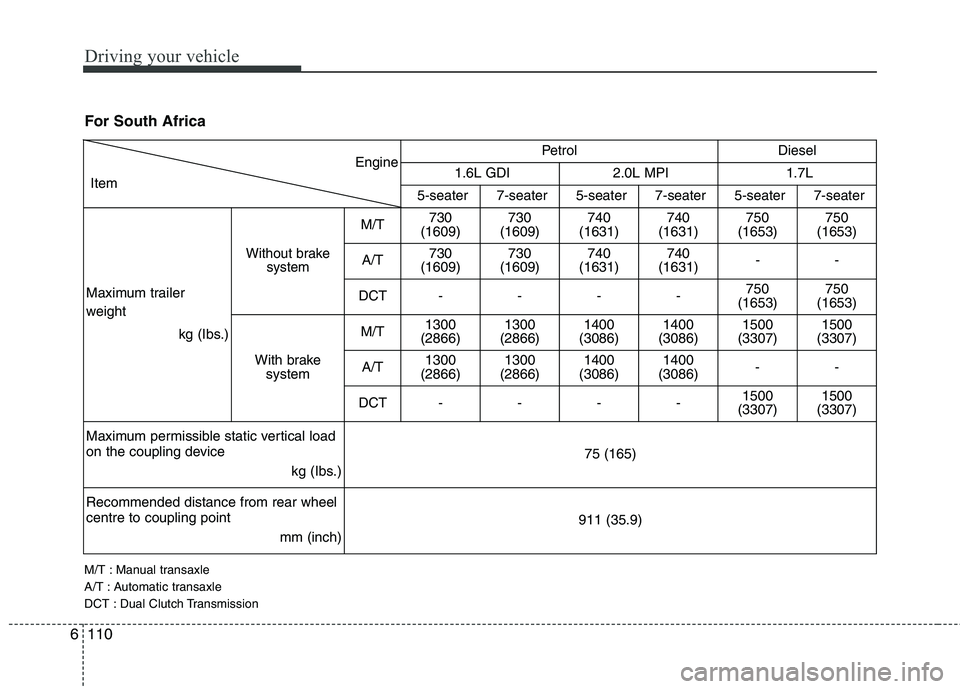
Driving your vehicle
110
6
Engine
ItemPetrol Diesel
1.6L GDI2.0L MPI 1.7L
5-seater7-seater5-seater 7-seater 5-seater 7-seater
Maximum trailer
weight kg (Ibs.)
Without brake system
M/T730
(1609)730
(1609)740
(1631) 740
(1631) 750
(1653) 750
(1653)
A/T730
(1609)730
(1609)740
(1631) 740
(1631) --
DCT---- 750
(1653) 750
(1653)
With brake system
M/T1300
(2866)1300
(2866)1400
(3086) 1400
(3086) 1500
(3307) 1500
(3307)
A/T1300
(2866)1300
(2866)1400
(3086) 1400
(3086) --
DCT---- 1500
(3307) 1500
(3307)
Maximum permissible static vertical load
on the coupling device kg (Ibs.)
75 (165)
Recommended distance from rear wheel centre to coupling point mm (inch)
911 (35.9)
For South Africa
M/T : Manual transaxle
A/T : Automatic transaxle
DCT : Dual Clutch Transmission
Page 546 of 723
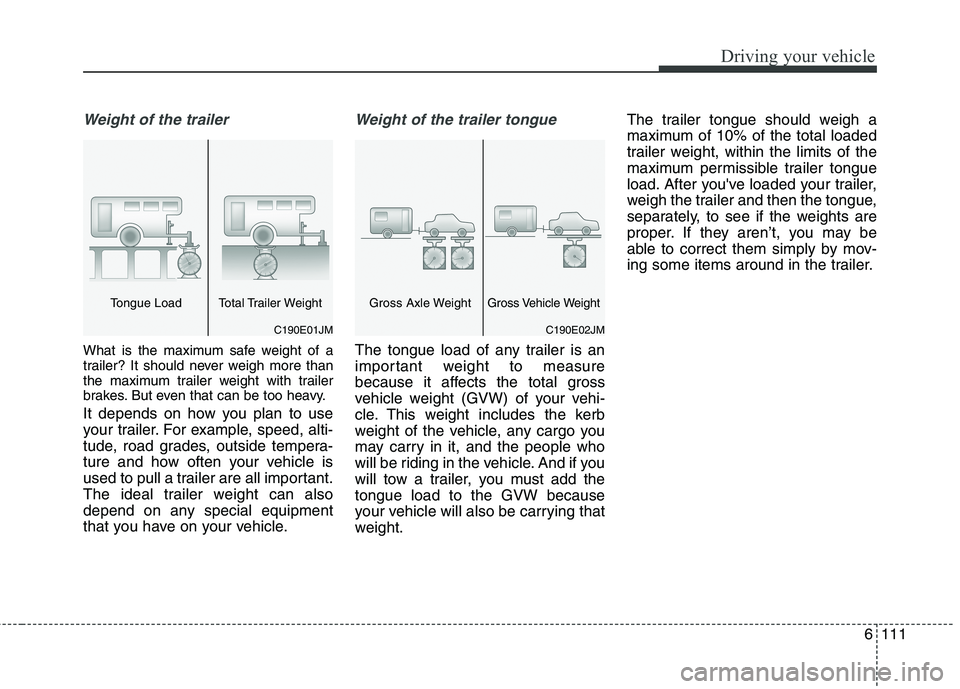
6111
Driving your vehicle
Weight of the trailer
What is the maximum safe weight of a
trailer? It should never weigh more than
the maximum trailer weight with trailer
brakes. But even that can be too heavy.
It depends on how you plan to use
your trailer. For example, speed, alti-
tude, road grades, outside tempera-
ture and how often your vehicle is
used to pull a trailer are all important.
The ideal trailer weight can also
depend on any special equipment
that you have on your vehicle.
Weight of the trailer tongue
The tongue load of any trailer is an
important weight to measure
because it affects the total gross
vehicle weight (GVW) of your vehi-
cle. This weight includes the kerb
weight of the vehicle, any cargo you
may carry in it, and the people who
will be riding in the vehicle. And if you
will tow a trailer, you must add thetongue load to the GVW because
your vehicle will also be carrying that
weight.The trailer tongue should weigh a
maximum of 10% of the total loaded
trailer weight, within the limits of the
maximum permissible trailer tongue
load. After you've loaded your trailer,
weigh the trailer and then the tongue,
separately, to see if the weights are
proper. If they aren’t, you may be
able to correct them simply by mov-
ing some items around in the trailer.
C190E02JM
Gross Axle WeightGross Vehicle Weight
C190E01JM
Tongue Load Total Trailer Weight
Page 547 of 723
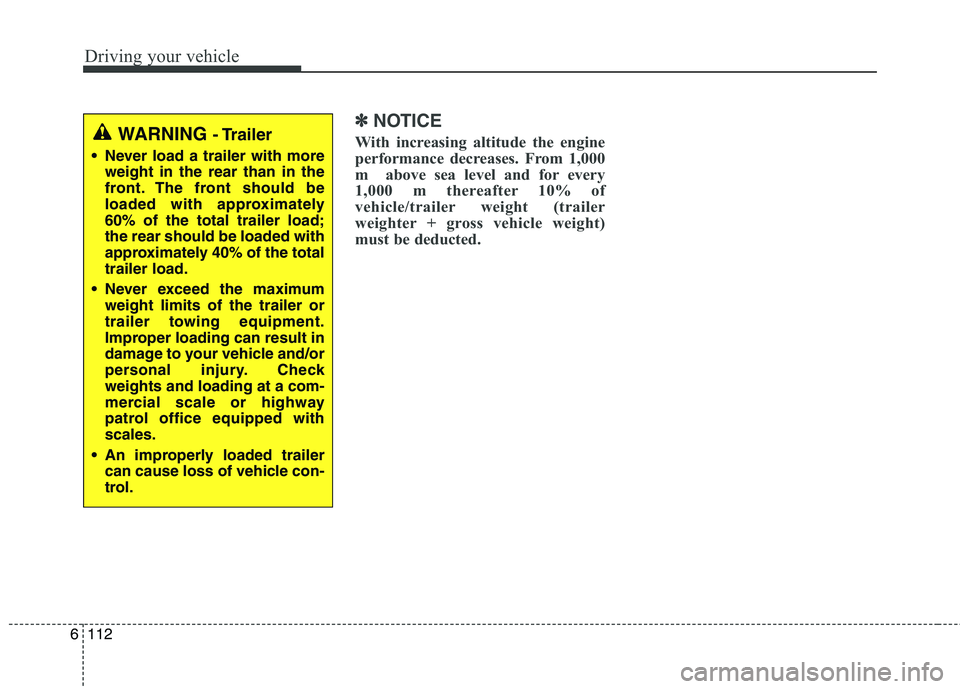
Driving your vehicle
112
6
✽✽
NOTICE
With increasing altitude the engine
performance decreases. From 1,000
m above sea level and for every
1,000 m thereafter 10% of
vehicle/trailer weight (trailer
weighter + gross vehicle weight)
must be deducted.WARNING - Trailer
Never load a trailer with more weight in the rear than in the
front. The front should be
loaded with approximately60% of the total trailer load;the rear should be loaded with
approximately 40% of the totaltrailer load.
Never exceed the maximum weight limits of the trailer or
trailer towing equipment.
Improper loading can result in
damage to your vehicle and/or
personal injury. Checkweights and loading at a com-
mercial scale or highway
patrol office equipped withscales.
An improperly loaded trailer can cause loss of vehicle con-
trol.
Page 548 of 723
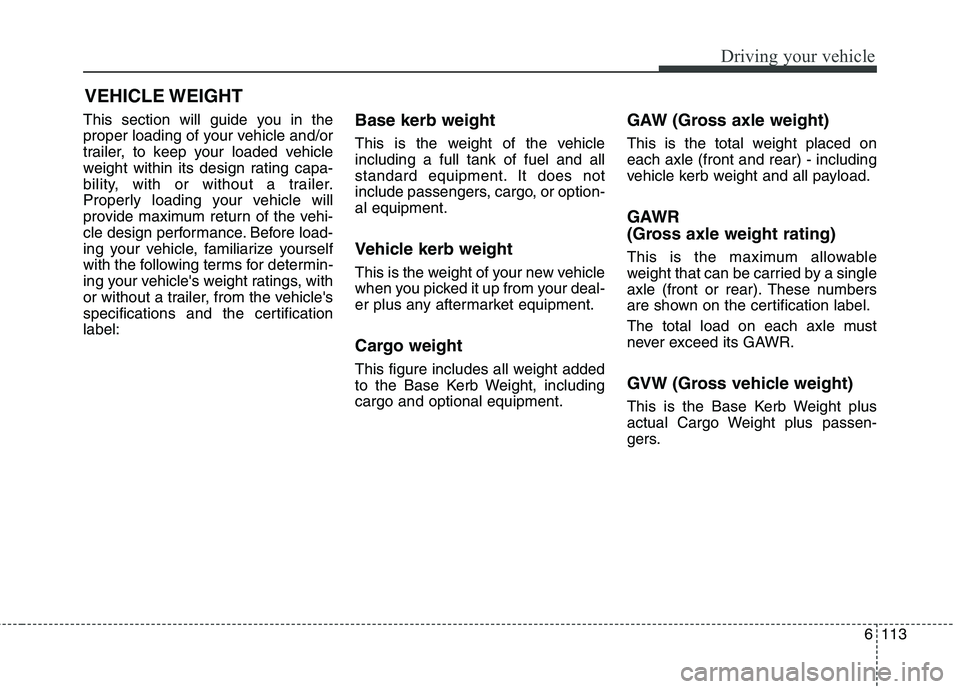
6113
Driving your vehicle
This section will guide you in the
proper loading of your vehicle and/or
trailer, to keep your loaded vehicle
weight within its design rating capa-
bility, with or without a trailer.
Properly loading your vehicle will
provide maximum return of the vehi-
cle design performance. Before load-
ing your vehicle, familiarize yourself
with the following terms for determin-
ing your vehicle's weight ratings, with
or without a trailer, from the vehicle's
specifications and the certificationlabel:Base kerb weight
This is the weight of the vehicle including a full tank of fuel and all
standard equipment. It does not
include passengers, cargo, or option-al equipment.
Vehicle kerb weight
This is the weight of your new vehicle
when you picked it up from your deal-
er plus any aftermarket equipment.
Cargo weight
This figure includes all weight added
to the Base Kerb Weight, includingcargo and optional equipment.GAW (Gross axle weight)
This is the total weight placed on each axle (front and rear) - including
vehicle kerb weight and all payload.
GAWR
(Gross axle weight rating)
This is the maximum allowable
weight that can be carried by a single
axle (front or rear). These numbers
are shown on the certification label.
The total load on each axle must
never exceed its GAWR.
GVW (Gross vehicle weight)
This is the Base Kerb Weight plus
actual Cargo Weight plus passen-
gers.
VEHICLE WEIGHT
Page 549 of 723
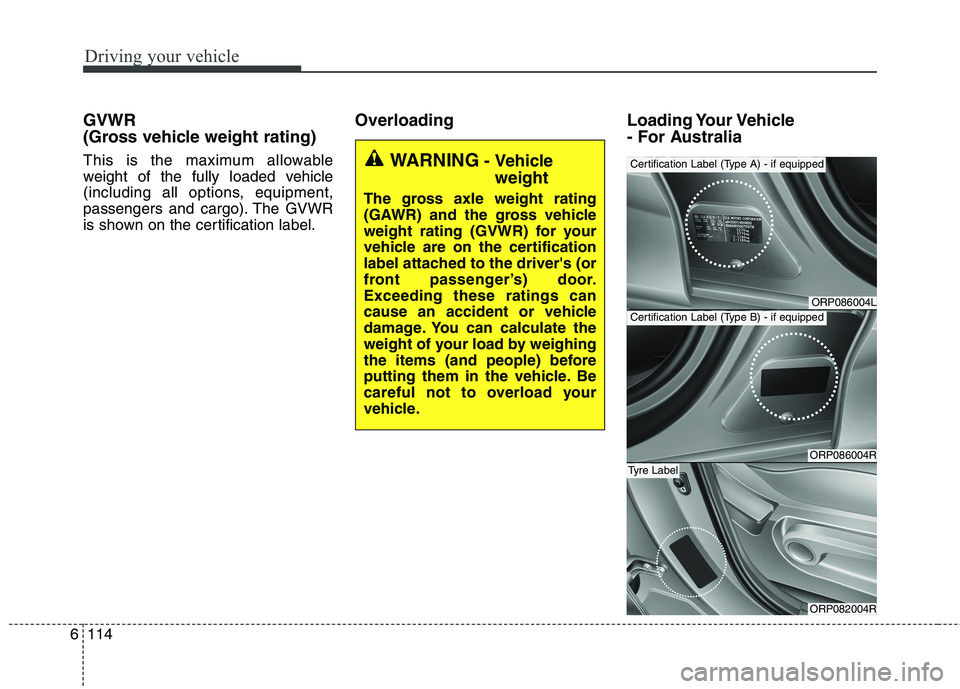
Driving your vehicle
114
6
GVWR
(Gross vehicle weight rating)
This is the maximum allowable
weight of the fully loaded vehicle
(including all options, equipment,
passengers and cargo). The GVWR
is shown on the certification label. Overloading Loading Your Vehicle
- For Australia
WARNING- Vehicle
weight
The gross axle weight rating
(GAWR) and the gross vehicle
weight rating (GVWR) for your
vehicle are on the certification
label attached to the driver's (or
front passenger’s) door.Exceeding these ratings can
cause an accident or vehicle
damage. You can calculate the
weight of your load by weighing
the items (and people) before
putting them in the vehicle. Be
careful not to overload your
vehicle.
ORP086004L
ORP086004R
Certification Label (Type B) - if equipped
Certification Label (Type A) - if equipped
Tyre Label
ORP082004R
Page 550 of 723
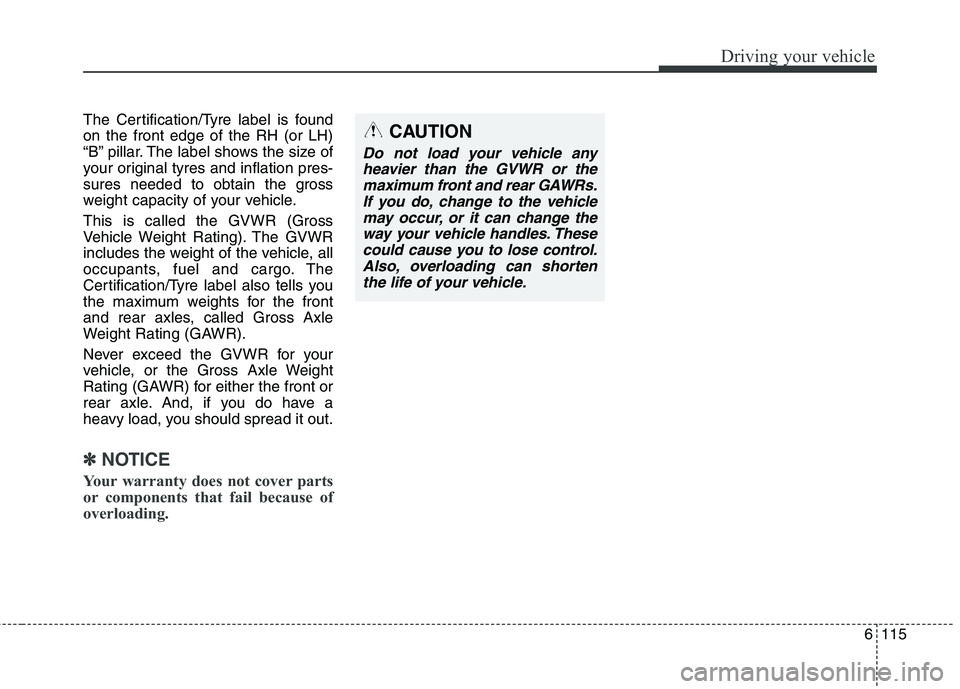
6115
Driving your vehicle
The Certification/Tyre label is found on the front edge of the RH (or LH)
“B” pillar. The label shows the size of
your original tyres and inflation pres-
sures needed to obtain the gross
weight capacity of your vehicle. This is called the GVWR (Gross
Vehicle Weight Rating). The GVWR
includes the weight of the vehicle, all
occupants, fuel and cargo. The
Certification/Tyre label also tells you
the maximum weights for the front
and rear axles, called Gross Axle
Weight Rating (GAWR).
Never exceed the GVWR for your
vehicle, or the Gross Axle Weight
Rating (GAWR) for either the front or
rear axle. And, if you do have a
heavy load, you should spread it out.
✽✽NOTICE
Your warranty does not cover parts
or components that fail because of
overloading.
CAUTION
Do not load your vehicle any heavier than the GVWR or themaximum front and rear GAWRs. If you do, change to the vehiclemay occur, or it can change theway your vehicle handles. These could cause you to lose control.Also, overloading can shortenthe life of your vehicle.